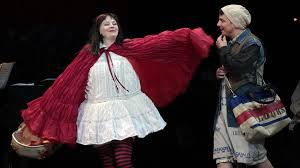out of the woods
by Douglas Messerli
James Lapine (book) and Stephen
Sondheim (music and lyrics) Into the
Woods / Beverly Hills, California, the Wallis Annenberg Center for the
Performing Arts presenting The Oregon Shakespeare Festival Production, December
20, 2014
James Lapine (screenplay, based on
his libretto), Stephen Sondheim (music and lyrics), Rob Marshall (director) Into the Woods / 2014
It seems strange, given my long
admiration for and knowledge of American musical theater, that I had not seen
Lapine and Sondheim’s successful musical Into
the Woods previously. I missed its original Old Globe Theatre production in
San Diego, shortly we after we moved to the West Coast (we were busily
attending almost nightly dinners and events in Los Angeles during 1986), and
for some explicable reason failed to see it in the late 1980s when it appeared
on Broadway. Even more inexplicable was our failure to see it in 2002 when it
was revived at the Ahmanson Theatre in Los Angeles and subsequently in New
York.
All was finally revealed to Howard and me in a resplendent, if slightly
trimmed-down version by The Oregon Shakespeare Festival, who were asked to
repeat their engagingly skeletal production for the second season of the
Beverly Hills Wallis Annenberg’s events.
This was not truly a “perfect” production—indeed given the work’s
convoluted story and its self-consciously witty lyrics and patter, along with
its bullet-quick pace, one wonders whether there could ever me a thoroughly
resolved performance—but it was certainly an excellent example of what musical
theater creativity is all about. If it was difficult, at times, to make out all
the lyrics (which reminded me a bit of my endlessly-rhymed couplets in my own
short musical attempts), we, along with the general audience, were certainly
moved by the blithe performances and more affected by the many deeper
subtleties of the Lapine-Sondheim telling.
No matter how it performs
in theaters, Stephen Sondheim’s and
James Lapine’s dark,
glorious and supremely messy fairytale
mash-up musical/therapy
session is now forever a pop-culture
curio unwary kids will
stumble upon, to their bafflement and
betterment. The
princess-party punch-bowl has forever been
spiked.
The Annenberg production rambled and gamboled through and around the
forest with hardly any sets, creating an enormous amount of locational
atmosphere simply with lights and costumes. Fortunately nearly all the performers
could act and, most importantly in this musical, could sing. Of my many
favorite moments, I’d be derelict not to mention Kjerstine Rose Anderson’s
touching wake-up call “I Know Things Now,” Jeremy Peter Johnson’s and Royer
Backus’s poignant paean to emotional suffering “Agony,” Rachael Warren’s
troubling either/or consideration “Moments in the Woods,” and, of course, the
musical’s inevitable show-stopper, “Last Midnight,” sung with nightclub zest by
Miriam A. Laube. But everyone in this production succeeded well in taking the
audience through the dark gnarls of woodland and out again into the safety of
Sondheim’s conforming vision of reality, where parents are warned about the
stories and words they tell to their children—including, presumably, the tale
we’ve just experienced.
Given all the dark elements of this work and its complexity of plot I
winced at the idea of Rob Marshall’s upcoming film rendition. I’d seen his
nervously–hyperventilated version of Chicago
What a surprise, accordingly, to find a nearly intact and, in many ways,
superior-to-the-play movie in a nearby theater. Sondheim musicals generally
dispense with dance (one of Marshall’s downfalls in Chicago), and, accordingly, he could concentrate this time in
bringing a story that suffers on the stage as characters go rushing in and off
into the theater wings. With movie-camera mobility, Marhsall maneuvers his
characters in tête-à-tête-like encounters as the neighbors go scurrying through
the forest. Some critics have understandably criticized this approach as
isolating the musical’s increasingly socialized figures, and certainly this
does have an effect on the second act when the quartet of survivors are forced
to work together in order to rid their world of a female giant; but Marshall’s
clearer delineation of the character encounters with one another also help to
make Lapine’s tale clearer, and brings greater focus upon each one of these
fairytale figure’s psychological desires and failures.
To devotees of the musical, which even after just having seen it, I had
already become, it is always disappointing, moreover, to find that some of the
songs of missing, including reprises such as the two Princes’ mocking
love-stricken duo, “Agony.” And I agree with some observers that cutting
important songs such as “No More,” in which the Mysterious Man (the Baker’s
long-dead father), sympathizing with the Baker’s determination to escape from
the wood (with lovely admissions such as “We disappoint, / We leave a mess, /
We die but we don’t”) makes the Baker’s decision to return to his friends and
new family somewhat inexplicable. But one has simply to expect those treasured
absences given the genre of cinema musicals.
I was less able to forgive the sanitizing of the Baker’s Wife’s tryst
with the Prince in the forest. The Disney film leaves us with the impression
that the “dangers” she has discovered which bring her to suddenly comprehend
it’s time to leave the woods have consisted of only a few kisses, instead of,
as the play demonstrates, a full-out, old-fashioned fuck. And accordingly, her
wondrous song after (excellently realized by Emily Blunt) does not make a lot
of sense.
But, again, if that minor concession allowed the rest of the film to
remain intact, I can live with it. The performances (made more important in the
close-up attention of the camera) and singing were uniformly excellent. As the
wolf, Johnny Depp was wily, suave, and lascivious in just the right amounts.
Okay, his witty lines (“Think of that scrumptious carnality / Twice in one
day…/ There’s no possible way / To describe what you feel / When you’re talking
to your meal.”) didn’t get the giggles it surely did on Broadway. I’d still
argue they were well sung. And the movie did even better with songs that got
somewhat lost in the busy run-arounds of the stage. By slowing down and
focusing on Anna Kendrik’s (as Cinderella) perplexing contradictory desires to
run and remain in “On the Steps of the Palace,” we suddenly were able to
comprehend and enjoy that lovely ballad. The young Daniel Huttlestone (as Jack)
truly made us feel that there were suddenly “Giants in the Sky.” The handsome, self-preening princes (Chris
Pine and Billy Magnussen) capably sang of their agonies while sporting about in
a waterfall. And Rapunzel (Mackenzie
My
only criticism of the star of the show, Meryl Streep as the Witch (an actress
about whom, I admit, I have often sounded like an old curmudgeon), was that she
played her part, even when singing, just a bit too well: in her gently sung
“Stay with Me,” Streep growled out some darker tones in a manner that
Bernadette Peters might never have imagined. I wanted to more clearly hear
Streep’s expressive coloratura, which has been denied us far too long—except
for a few quick ditties in Robert Altman’s A
Prairie Home Companion and some saccharine standards in Phyllida Lloyd’s Mamma Mia!. But Streep made up for it
with a full-throttle rendition of “Last Midnight” and an offstage, show-worthy
voicing of “Children Will Listen.” Like Dickens’ Oliver Twist, I simply wanted
“some more.”
Sure, the movie version of Into
the Woods was not perfect…but as I said above I can’t imagine any
production of the musical-comedy equivalent of King Lear to ever be everything it aspires to. There’s way too many
fascinating characters, too many plot possibilities, and far too many cleverly
rhymed couplings to allow any directorial vision to get it just right. That
Marshall achieved so much perfection is a kind of miracle in itself. His Into the Woods might, in the end, be one
of the best of musical movies—and I’ve seen most of them—on record.
Los Angeles, December 27, 2014
Reprinted from USTheater, Opera, and Performance (December 2014) and World Cinema Review (December 2014).



















